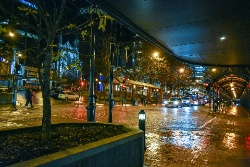New era begins today for Johnsonville train passengers
MEDIA RELEASE FROM GREATER WELLINGTON REGIONAL COUNCIL AND KIWIRAIL
New era begins today for Johnsonville train passengers
Passengers travelling to and from Johnsonville will today make their journeys on the first new trains on the Line in 60 years.
Peter Glensor, chair of Greater Wellington’s Economic Wellbeing Committee, which oversees public transport, says from late this morning every train to and from Johnsonville will be a new Matangi train.
“These are the first new trains on the Johnsonville Line in more than 60 years, so it’s a significant milestone for the region’s rail network.”
“Johnsonville rail commuters have been waiting a long time for these new trains, and while it is both a happy and sad moment to see the English Electrics retired from service on the Johnsonville line, we have had our challenges in keeping them running,” says KiwiRail’s General Manager of Passenger Services, Deborah Hume.
“Having Matangi now operating all services on the Johnsonville line is a much anticipated improvement to Tranz Metro’s reliability and capacity on this line. I would like to acknowledge the patience of Johnsonville customers, and am very pleased to be able to be able to offer passengers a more efficient, comfortable and reliable service,” Ms Hume says.
The last English Electric services will run to Johnsonville at 10.32am and from Johnsonville at 11am.
“Johnsonville commuters travelling
home today will enter a new era of train travel. We’re
getting very positive feedback about the new trains. They
feel modern and spacious, they’re air-conditioned, and the
public address systems are top quality.
Peter Glensor
says passengers on the Johnsonville Line will be able to
take cycles on the new trains at any time – peak hour and
non-peak hour. “Passengers cannot take their cycles on
Matangi trains on the other lines (Upper Hutt and Kapiti)
during peak times because they take up seating space which
is in high demand. However, peak hour passengers numbers are
lower on the Johnsonville Line so we’re trialling this
change in the cycles on trains policy. It will be reviewed
in a few months’ time.”
A of work has been done on the
line to accommodate the bigger, modern trains. This work,
which was led by KiwiRail and cost $17m,
included:
• Lowering and widening the seven tunnels on
the line
• Lowering a rail bridge in Ngaio Gorge and
lowering the track under the Raroa Station
overbridge
• Lengthening the three crossing loops at
Ngaio, Khandallah and Wadestown to enable longer trains to
run
• Reconstruction of some platforms and upgrades to
the rest at all eight stations
• Installation of a new
power substation at Ngaio
“The line is also very steep,
rising to 150 metres above sea level, which was one of the
many challenges we had to meet with the design of the new
trains. And we’re delighted that they’ve passed all the
Johnsonville tests with flying colours.
More than half of
the new Matangi fleet, 28 out of 48 trains, has been
approved for service. Almost 75 percent of the fleet has
been delivered to Wellington. All the trains are expected to
be in Wellington within the next six months and in service
before the end of the year.
• The Johnsonville Line is
a 10.5 km suburban passenger railway line between
Johnsonville in the north and the Wellington Railway Station
in the south. The stations served by the line are:
Johnsonville; Raroa; Khandallah; Box Hill; Simla Crescent;
Awarua Street; Ngaio; Crofton Downs and Wellington. More
than 100,000 journeys are made on the line each
month.
• It is a single track line with seven tunnels,
and three sets of passing loops - at Wadestown, Ngaio
Station and Khandallah Station. The line rises
approximately 150m from Wellington Station to Johnsonville
and the line’s ruling gradient is 1 in 20.4.
• The
Thorndon-Tawa (via Johnsonville) line was opened in 1885 by
the Wellington & Manawatu Railway Company after blasting
through significant amounts of rock and negotiating steep
gorges. The Company later sold the line to the Government
in 1908 which in turn fell into disuse after the 1937
completion of the North Island Main Trunk (NIMT) Railway
Tawa deviation, which allowed the steeply graded
Johnsonville saddle to be bypassed.
• Wellington City
Council was subsequently offered the use of the line for the
City’s tramway network, but the offer was declined. This
resulted in the Government deciding to close the Tawa to
Johnsonville section of the line. In 1938 the Government
upgraded the remaining Johnsonville to Wellington section,
resulting in New Zealand’s first electrified suburban
passenger railway, using purpose-built electric multiple
unit trains and making Wellington the third city in
Australasia to electrify its first suburban railway line.
• The first of three batches of English Electric
Multiple Unit trains were introduced between 1938 and 1953
– and some of these are still in service. The last
English Electric will run on the Johnsonville Line at 11am
on Monday March 19, meeting the first Matangi at Ngaio
Station. A small number of English Electrics will continue
to run on other lines for a few months. A decision will be
made soon about what will be done with them when they are
taken out of service.
• From Monday 19 March the line
will be served by a fleet of 12 Matangi cars. Four-car sets
will be used for all peak hour services and two-car sets for
off-peak services.


 Gordon Campbell: On The Hamas Ceasefire Offer, And Mark Mitchell’s Incompetence
Gordon Campbell: On The Hamas Ceasefire Offer, And Mark Mitchell’s Incompetence Wellington Office of the Mayor: Mayor Responds To Housing Minister’s District Plan Decision
Wellington Office of the Mayor: Mayor Responds To Housing Minister’s District Plan Decision Stats NZ: Have Your Say On Modernising The Census
Stats NZ: Have Your Say On Modernising The Census NZ Government: Therapeutic Products Act To Be Repealed
NZ Government: Therapeutic Products Act To Be Repealed The Treasury: Interim Financial Statements Of The Government For Nine Months Ended 31-3-2024
The Treasury: Interim Financial Statements Of The Government For Nine Months Ended 31-3-2024  Government: New Zealand Sign Language Week An Opportunity For Anyone To Sign
Government: New Zealand Sign Language Week An Opportunity For Anyone To Sign ACT New Zealand: Investment In Prisons Delivers On ACT Commitment
ACT New Zealand: Investment In Prisons Delivers On ACT Commitment


